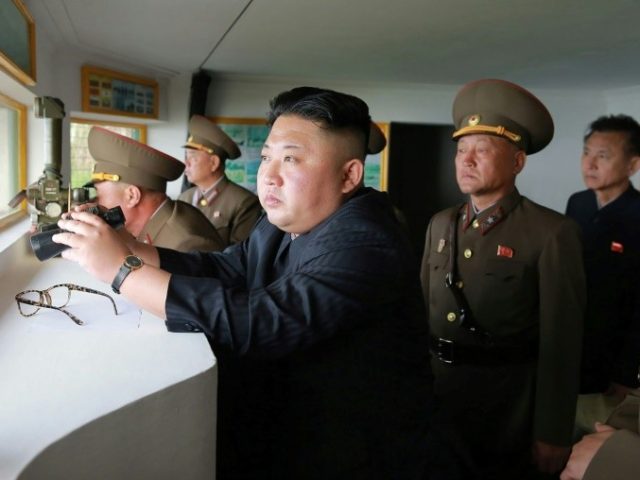This morning’s key headlines from GenerationalDynamics.com
- North Korea launches medium-range ballistic missile
- North Korean missile launch sends a message to everyone
North Korea launches medium-range ballistic missile

South Koreans in a Seoul railway station on Sunday morning watch North Korea’s ballistic missile test (AP)
North Korea’s state media says that the country launched a medium-range ballistic missile on Sunday, capable of carrying a nuclear warhead.
According to state media, the child dictator Kim Jong-un personally “guided the test-fire,” and bragged about its nuclear prowess:
Pyongyang, May 15 (KCNA) — A test-fire of new ground-to-ground medium long-range strategic ballistic rocket Hwasong-12 was successfully carried out on Sunday by scientists and technicians in the field of rocket research, who are bravely advancing toward a new goal to be proud of in the world, true to the far-sighted idea of Kim Jong Un, chairman of the Workers’ Party of Korea, chairman of the State Affairs Commission of the DPRK and supreme commander of the Korean People’s Army, for building a nuclear power.
Kim Jong-un guided the test-fire on the spot…
He declared that the DPRK is a nuclear power worthy of the name whether someone recognizes it or not. He stressed the DPRK will keep strict control over those engaging themselves in nuclear blackmail with its nuclear deterrence which has been unimaginably and rapidly developed.
The missile traveled almost 500 miles in 30 minutes, and landed in the Sea of Japan, surrounded by the Korean peninsula, about 60 miles south of Russia’s Vladivostok region and approximately 250 miles from Japan.
The missile was launched at the highest possible angle, so that it would travel high into the air, but would limit the lateral distance, and so it reached an altitude of about 1,300 miles. If it had been fired at a standard trajectory, then it would have had a range of at least 2,500 miles, meaning that it could have reached Russia and Japan, and probably the U.S. base at Guam.
Initial reports speculated that it had been an advanced KN-15 missile, from a mobile launcher and with a solid-fuel engine. The mobile launcher allows the missile to be hidden until minutes before launch, and the solid-fuel engine allows it to be ready to launch immediately at any time.
However, it is now believed that it was a KN-17 missile, a single-stage, liquid-fueled missile. Tests with both the KN-15 and KN-17 missiles provide experience and data for ongoing development of an intercontinental ballistic missile (ICBM) that could reach Australia or the United States.
The United Nations Security Council will meet on Tuesday to discuss the situation. They are expected to issue a statement condemning the missile test, calling it “unacceptable,” and threatening that if there’s another test then the Security Council will hold another meeting. KCNA Watch and 38 North and Fox News and Reuters
Related Articles
- North Korean missile strikes sea close to Japan, threatening radar base (04-Aug-2016)
- China-North Korea tensions high after nuclear test (09-Jan-2016)
- U.N. promises ‘response’ to North Korea firing midrange missiles (30-Mar-2014)
North Korean missile launch sends a message to everyone
The timing of the missile launch on Sunday sends messages to officials in various countries:
- The launch occurred right in the middle of China’s highly prestigious “One Belt One Road” forum in Beijing, attended by 1,200 delegates from 110 countries, that we described yesterday. This was evidently a planned major insult to China’s president Xi Jinping, who is preaching international harmony at the forum.
- The test also sent a strong message to South Korea’s new president Moon Jae-in, who took office only last week after an election campaign promising to develop closer ties with North Korea. Some South Koreans feared that he would be too soft on North Korea, but Moon dispelled those concerns by strongly condemning the test, calling it a “grave threat” to regional security and a clear violation of U.N. Security Council resolutions.Moon had hinted that the US deployment of the Terminal High Altitude Area Defense (THAAD) might be reversed, acceding to China’s wishes. However, the missile test throws those suggestions into doubt.
- Australia’s foreign minister Julie Bishop said, “Clearly the aspiration of the North Korean regime is to develop an intercontinental ballistic missile that has the capability of dumping a nuclear payload on the US.”
- Russia, a long-time ally of North Korea, said through military officials quoted by the Interfax news agency that the missile posed no danger to Russian territory.
North Korea’s biggest message of all is that development of nuclear weapons and ballistic missiles is going to continue, at least until North Korea has an intercontinental ballistic missile that can reach Los Angeles, and that it will do so despite the wishes of China or any other country. CNN and Korea Times and Yonhap (Seoul) and The Australian and LA Times
Related Articles
- China launches ‘One Belt One Road’, raising objections and violent protests (14-May-2017)
- Ancient tensions flare between China and North Korea (08-May-2017)
KEYS: Generational Dynamics, North Korea, Kim Jong-un, Russia, Japan, KN-15, KN-17, China, One Belt One Road, Xi Jinping, South Korea, Terminal High Altitude Area Defense, THAAD, Moon Jae-in, Australia, Julie Bishop
Permanent web link to this article
Receive daily World View columns by e-mail

COMMENTS
Please let us know if you're having issues with commenting.